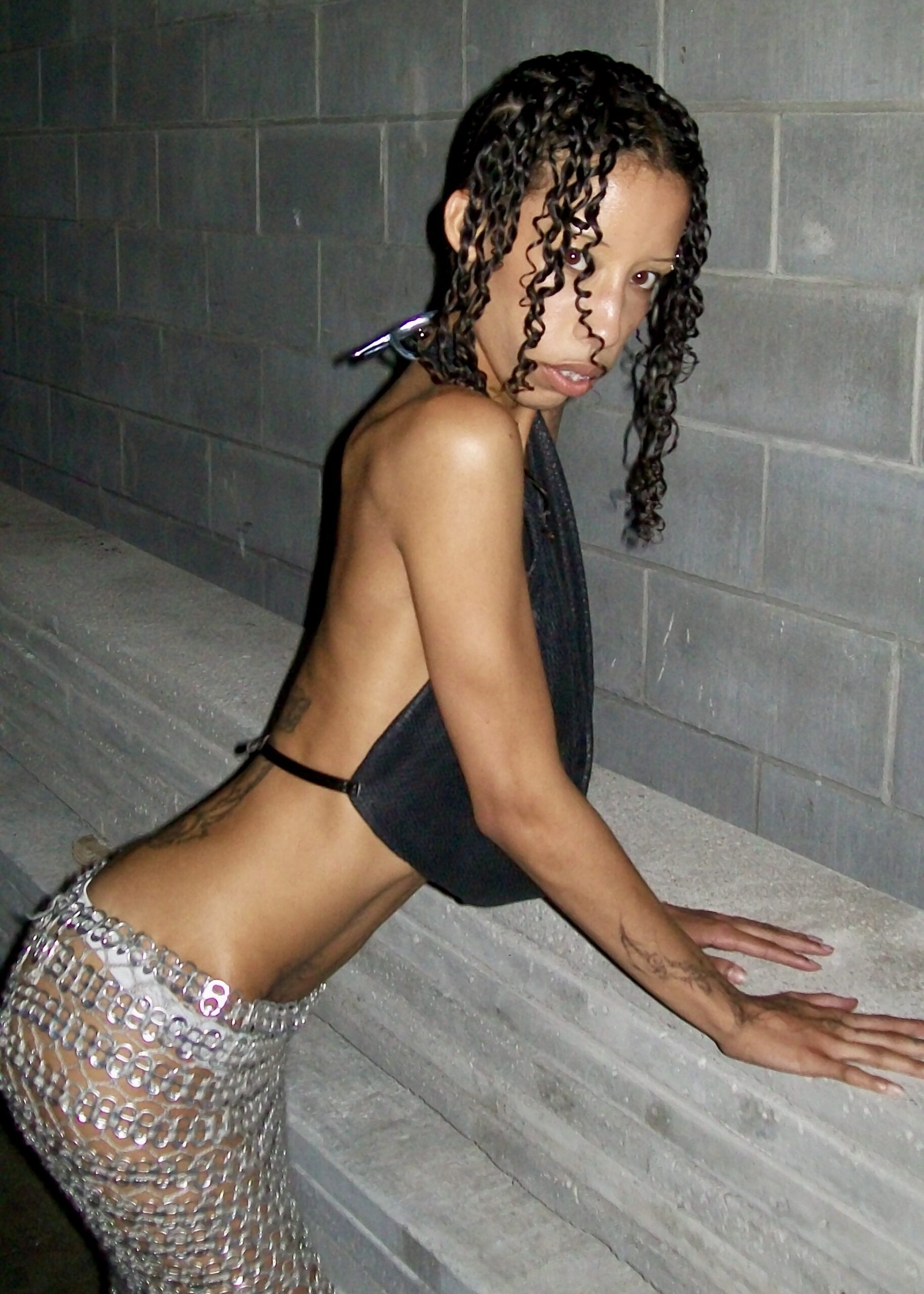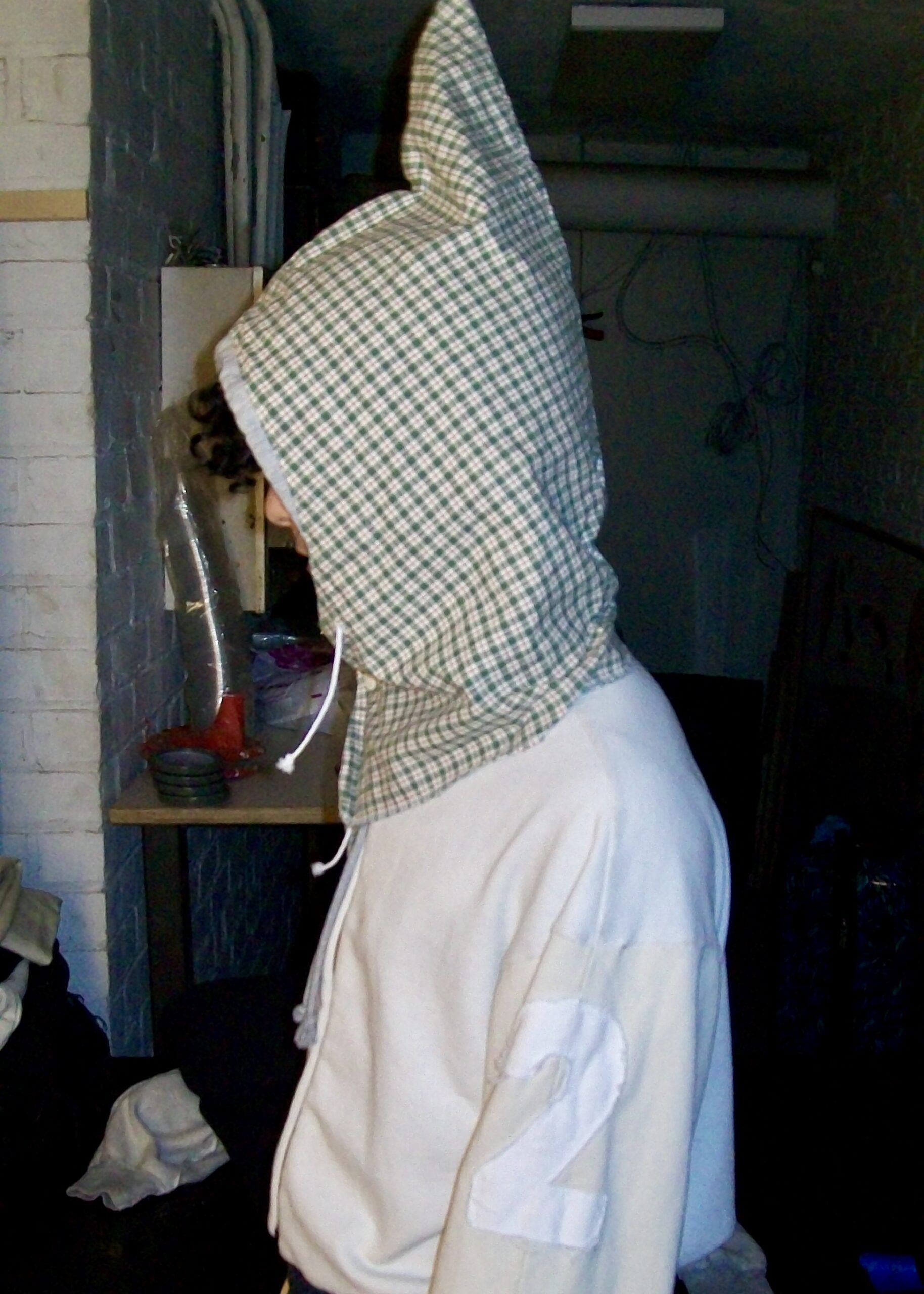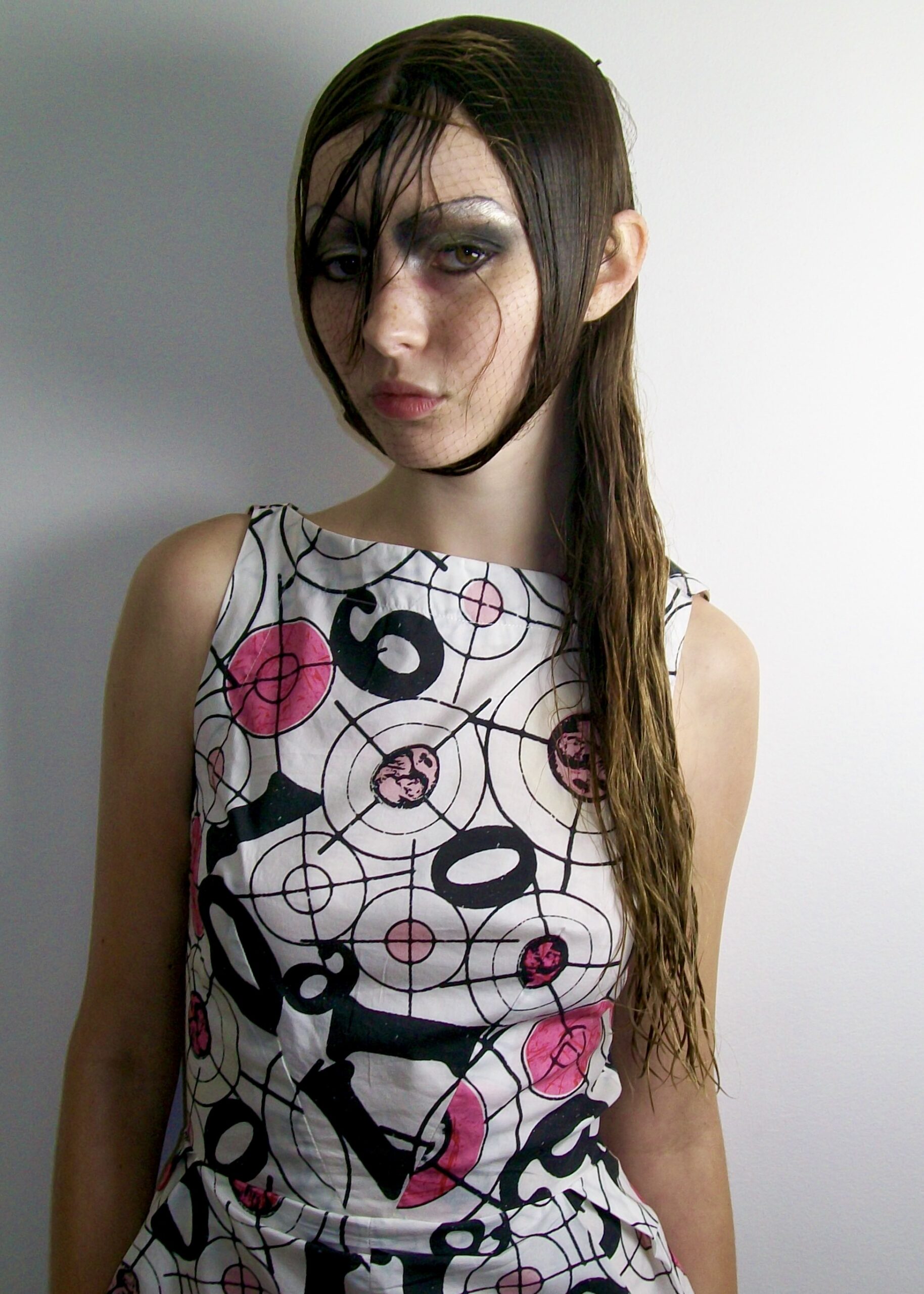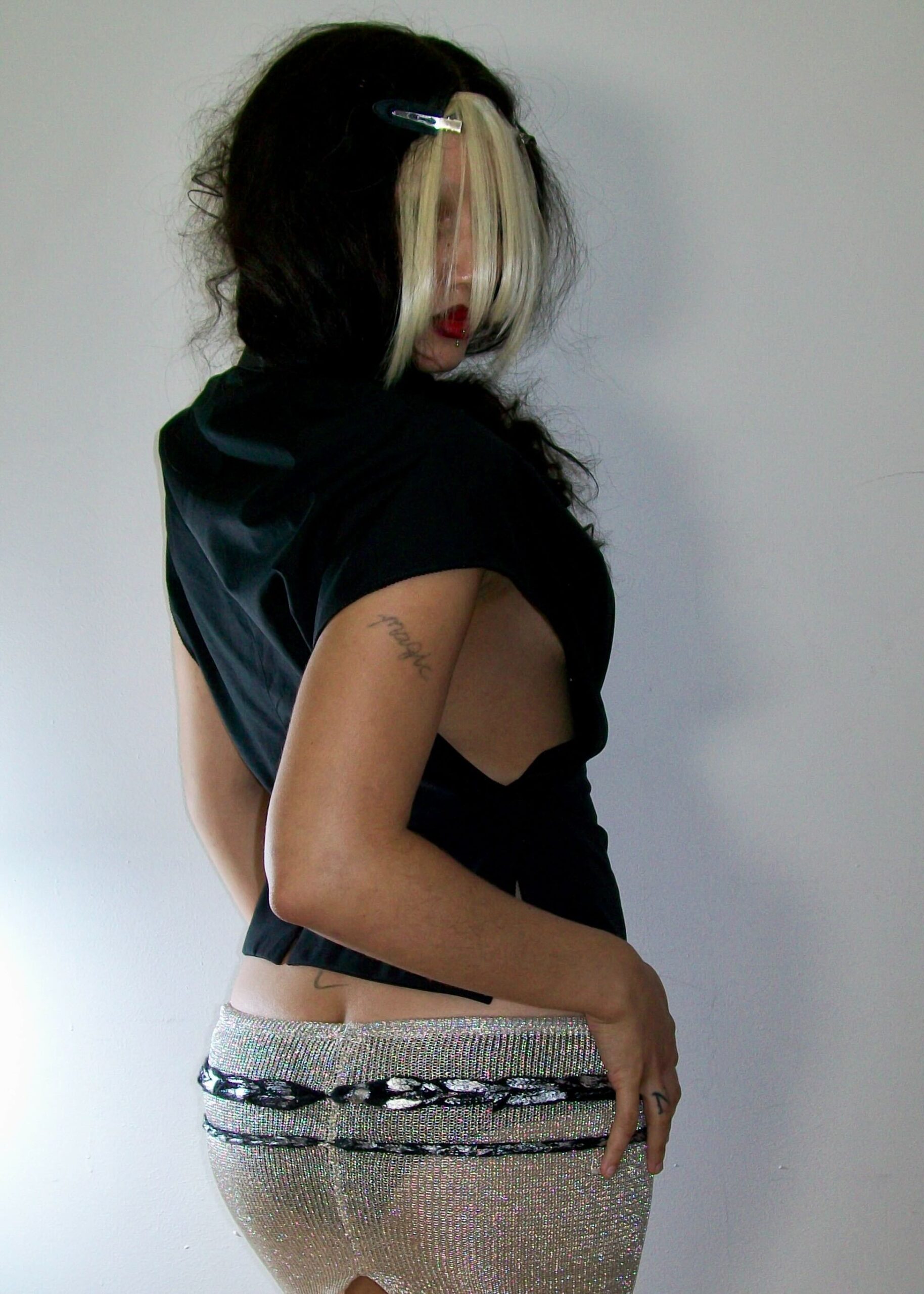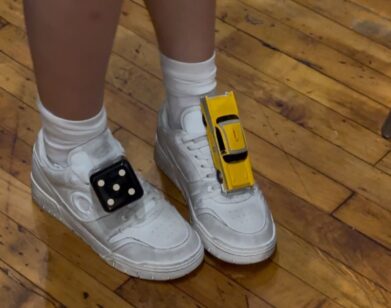NYFW
“It’s About the Ease of Dressing”: Meet NYC’s Three Hottest Young Designers
This NYFW was all about the indie designers, and there are some newcomers on the scene. We stopped by three of the most-hyped sophomore shows of the season to see what has the underground excited. At 154 Scott last Wednesday, Shame kicked off fashion week by taking over a basement enclosed in plastic with her erotic revenge fantasy. Blasé lingerie and recycled metal garments met thumping club music and lights at “Lumpen,” designer Ramona Beattie’s ode to slutty debauchery. Then, on Monday, Brandon Lajoie of Skip Fame presented his second-ever show in the city at the downtown livestreaming hub 93 Canal, where the Montreal designer unveiled a 24-hour video project, “TWO 4 OLLIE,” which documented the development of his apocalyptic upcycled menswear looks. It all culminated in a cryptic fashion show-cum-music performance, where boys in menacing shoulder pads and shearling sets encircled the singer Thanks God under hyperlink-blue lights. And for fashion week’s off-calendar closer, Ben Doctor brought us into his romantic fantasy at his womenswear show, “Roulette,” where military-inspired minidresses and dramatic feathered hats turned out a packed Tribeca studio. Despite the post-war and recession vibes fresh on every brand’s conscience, one could almost feel hopeful about the future of New York fashion.
———
SHAME
MEKALA RAJAGOPAL: How are you feeling?
RAMONA BEATTIE: I’m so relieved. I feel like in the last 30 minutes it all came together.
RAJAGOPAL: How long were you working on the show?
BEATTIE: I actually started working on the collection in October of last year, and I was just making basics for me and my girlfriend to wear. I was planning on doing a show in February, but I couldn’t get the funds together. I did a show last year and I was so glad I did it, but I was dead broke for months after.
RAJAGOPAL: When did you start making clothes?
BEATTIE: I started sewing when I was a little kid. Probably when I was 10 or 12. I’ve always known I wanted to do it. And then, I went to school in Chicago at SAIC and I took a lot of technical classes in the fashion department. I’m very process-involved and my hands have to touch everything, which is a blessing and a curse. But I think it makes things feel really personal.
RAJAGOPAL: How long have you been in New York?
BEATTIE: I’ve been in New York since 2019. But I started to get a sense of what my concept was as I was making clothes last year.
RAJAGOPAL: So you’re thinking about what you personally want to wear?
BEATTIE: Yeah, kind of like a uniform. Right now, it’s just been sweatpants and a bra and a tank top, so I wanted to make the perfect fitted sweatsuit that was kind of a reprisal of that silhouette. I really love very simple things that are very comfortable to wear, but with really interesting details, like that thick zipper on the hoodie and all those cowl necks. I started making cowl neck tops when I didn’t have anything to wear. Right before going out, I was like, “Wait, I can drape it.” It’s about the ease of dressing.
RAJAGOPAL: I’m curious about “Lumpen,” the name of the show.
BEATTIE: The character is kind of an ambiguous criminal. I chose “Lumpen,” first of all, because I love the sound of that word, and also because it’s kind of in defense of the Lumpenproletariat. We’re in this moment of like, this insane collapse and all these things kind of crumbling, and we’re seeing that people who skirt the lines of the law are actually very knowledgeable and know how to take care of each other and themselves. That comes from me being a sex worker. That’s the most personal part of it, and kind of being pro-crime in general.
RAJAGOPAL: Yeah, totally. The cowl necks really reminded me of stripper dresses and how that style is still stuck in the ‘90s.
BEATTIE: Exactly. I wanted it to feel, across the spectrum of gender, slutty, you know? And that goes with the jockstraps, too.
RAJAGOPAL: And different angles of butts. Is it more about the under butt, or is it more about the upper butt crack? What’s the superior shape?
BEATTIE: I’m really feeling lower butt cleavage right now. I feel like it’s really underrated. But I always do like a super low waist, and part of that is the little bumster cut that I love.
RAJAGOPAL: I love the low waist on the tracksuit. And there were some cool materials. Were you using wax?
BEATTIE: The pants were lambskin, and then there was a pair of pants that are denim that I just painted black. There was a cowl top that’s embossed leather. Yeah, there were a few things that I laser cut, but you couldn’t really tell it’s laser cut. Like a cowl top that’s different on the inside.
RAJAGOPAL: And the idea of a disengaged class kind of goes hand in hand with just wanting to throw on a uniform. I think there’s a lot of discourse right now about Gen Z being jaded.
BEATTIE: I feel like it’s not necessarily for me about being disengaged so much as creating a system of dressing so that you can go do crimes. That’s why there’s the briefcases, because there’s little heists going on. I was really inspired by movie chase scenes and women and femmes losing it a little in this naughty way, but it serves a greater purpose at the same time. It’s not just debauchery. I really like when debauchery is channeled to become something that’s more meaningful.
RAJAGOPAL: Yeah. I always feel like I have a different interpretation of karma in that sense.
BEATTIE: Exactly, I like that. A lot of my creative production comes from feeling kind of vengeful in some ways from my experiences, mostly as a sex worker, and channeling those feelings into images.
RAJAGOPAL: Do you identify as a lingerie brand?
BEATTIE: My little slogan underneath my logo says “Fine erotic goods.” It’s not really lingerie, it’s just horny.
RAJAGOPAL: There is a very off-handedness about it when normally lingerie is shown in a very perfectionist way. It’s like, even though I’m just wearing a bra and a jockstrap, everything’s hanging off and I don’t really give a fuck. And she carried a hammer.
BEATTIE: I actually brought a baseball bat for that look. The idea is she is chasing someone down in a hotel in her bra and underwear. I think she carried the hammer instead.
RAJAGOPAL: Yeah, I definitely noticed. I like the glam a lot.
BEATTIE: My friend went to Texas recently, and there are just wild deer that hang out by their house, and there was one that they took a picture of that literally had really long eyelashes. That was the makeup inspo.
RAJAGOPAL: What media are you always inspired by?
BEATTIE: I’m really obsessed with female revenge. Like the girl from Audition.
RAJAGOPAL: Have you watched the movie Revenge? It’s about a woman who’s a sex worker trapped in the desert and becomes this Lara Croft kind of character and kills them.
BEATTIE: Wait, I have. I love movies like that. It’s just so inspiring.
RAJAGOPAL: What’s your ideal weapon?
BEATTIE: Something concealable and surprising. Something high-tech that is really cheap to make. I like a DIY weapon. Poison’s a good one.
RAJAGOPAL: Poison is chic. They don’t do poison anymore.
BEATTIE: They don’t.
RAJAGOPAL: The show felt like a party, with the lights and the bass up high.
BEATTIE: I mean, that’s Thoom. Once I heard that soundtrack, I was like, “Okay, everything’s going to be fine.”
RAJAGOPAL: Did you make this set?
BEATTIE: They built this out for Luar, and we just threw the soda tabs everywhere.
RAJAGOPAL: What are those about?
BEATTIE: I always try to do something recycled, because I just love trash. Especially in a metaphorical way. And I kind of love the idea that trash doesn’t actually exist. Everything is just here. Nothing is actually trash. It kind of relates to the trashiness of some of the style.
RAJAGOPAL: And this is a perfect venue to think about trash, because there’s a recycling plant across the street literally scooping up garbage in view of the show.
BEATTIE: Yeah. I wanted to actually do it at a scrap yard at first, but it’s hard to do an outdoor show. I heart recycling.
RAJAGOPAL: Some people think recycling is fake.
BEATTIE: I do think that the way it’s done is fake, because only something like 10% of it gets recycled. But it’s because people don’t know how to sort it. I’m actually kind of obsessed with sorting my recycling properly. But I think the best way for me to recycle is to make my own stuff out of trash.
RAJAGOPAL: So you know it’s actually happening.
BEATTIE: Yeah, I don’t really believe in recycling in the traditional sense.
RAJAGOPAL: I love that. That’s the pull quote.
———
SKIP FAME
RAJAGOPAL: You guys put this show together super fast. What was that like?
BRANDON LAJOIE: We were working on the show for a couple of weeks. We had a few inconveniences in between, but towards the end I feel we both [Lajoie and Gregory Miller] started applying more pressure. It was similar to the last one.
RAJAGOPAL: And you just got to the city last week. Where are you from?
LAJOIE: I’m from Montreal, and my family’s from Jamaica.
RAJAGOPAL: Does your upbringing affect the way that you approach making clothes?
LAJOIE: Montreal is such a cold city and you spend most of the year bundled up. So I think a lot of my approach to design is oriented around winter, and how to have range and style in the cold. Other than that, I think a lot of influence comes from my father, and watching how he carried himself and how considerate and thoughtful he was of his style. He instilled a lot of awareness of how style affects you and the way you carry yourself.
RAJAGOPAL: You use shearling and long johns and all these protective armors that people use in the cold. It reminds me of how the cold and the winter can have a doomsday vibe sometimes, and the collection has the same kind of gloom to it.
LAJOIE: For sure. I think that it feels very survival mode.
RAJAGOPAL: What media are you inspired by?
LAJOIE: Alien 3. It came out in the ‘90s. I love it because the costume design was all basically upcycled military clothing, so it’s all very tactical and functional. It’s reminiscent of the real world, but still different enough to embody the world that they’re developing. There’s a website I discovered that basically shows all the costume design that a friend put me on to, and it really stuck with me. The color palette, the functionality, and the outerwear emphasis, and the upcycling aspect.
RAJAGOPAL: Is that what the twos you use on the clothes represent?
LAJOIE: Exactly. The two basically represents giving old clothes a second life. And there’s something symbolic about two in the sense that it takes two to make one. It’s a number of creation and of repurpose, so it’s like a subtle symbol.
RAJAGOPAL: Why did you decide to start playing with shapes and do the exaggerated shoulders?
LAJOIE: I wanted to experiment with silhouettes to see how it can alter your physique, kind of creating different variations of your own self.
RAJAGOPAL: Like different avatars in a game or something.
LAJOIE: Exactly that. Choose your own character.
RAJAGOPAL: And you didn’t go to college, right? How did you develop your own education?
LAJOIE: Yeah. When I was in high school, I failed every year. Every year they would give me the option to change schools, so every year I decided to go to another school until my last year of high school, when I ended up at an alternative school. There were only 60 students in the entire school, so it was very intimate and hands-on. We had an art class where we would get donated different art materials, and one day we got sewing machines that no one used. So I asked my art teacher if I could sew instead of doing art assignments. She basically taught me how to thread the machine and I really liked the whole process, so I decided to ask around if anyone had a sewing machine I could borrow, and my science teacher had a little home machine that he ended up giving to me. So now I had a machine to bring home that I would use constantly with any material I had access to. I was very privileged to have teachers who were so supportive and wanted to help me.
RAJAGOPAL: Did you work with anyone else?
LAJOIE: I got an internship locally at this very small womenswear brand in Montreal, and I was a seamstress and a pattern cutter. I noticed that all the garments I was making were being sold in the stores and it gave me so much confidence that I could do the same for myself. After that, I spent five or six years just developing my own catalog. That’s as far as my formal training goes. I was basically able to be taught traditionally in an untraditional way, and it helped me skip a lot of unnecessary steps.
RAJAGOPAL: You were just locked in making clothes, and I think that’s an interesting thing because most people are, like, scrambling to finish their collections beforehand. So the issue is more of “How am I going to present all these clothes?” rather than “What am I going to make?” Maybe that allows you to be more considered about how you want to frame it.
LAJOIE: Yeah, that’s a great point. I overwhelm myself with deciding what I want to show rather than with trying to make enough. [Laughs] I have such a vast catalog that’s never seen the light of day and it’s just the challenge of presenting it. I have garments that I made six or seven years ago that I’m showing now. It’s kind of crazy. It’s new to everyone but old to me.
RAJAGOPAL: And you don’t live here, but you’ve been able to build up a lot of excitement here.
LAJOIE: New York is an interesting place. It’s like a peak capitalist society. I feel like people come to New York to do what they wanna do, so I’ve been able to gravitate towards people who reflect my interests and it gives me new perspective on what I’m doing. Definitely Greg [Miller, Lajoie’s collaborator]. I got very motivated to do this while working with Greg, so I honestly couldn’t imagine doing something like this without him. Definitely Lauren [Boyle], Tony too. Prophet, Neon, Emmanuel, for sure. Dax, for sure.
RAJAGOPAL: Both of your shows this year were kind of unconventional in the sense that you didn’t structure them like typical fashion shows or invite people. They blurred lines between a show and something else, like a party or a video.
LAJOIE: I try to do things in a way that feel comfortable to me and not limit myself to following rules. Even though that may do me a disservice at times, I feel a lot more confident taking my own approach. I don’t want it to feel generic and predictable. I like leaving room for interpretation. It makes it feel like I’m doing something new.
RAJAGOPAL: You were streaming on 93 Canal for 24 hours for this show?
LAJOIE: Yeah, we were documenting the whole process of the last few moments of preparation. So castings, fittings, styling, shooting, set design and production. I feel like everyone involved is doing it because they wanna be involved for what it is and the ideas, rather than hype or an opportunity. That makes it feel very personal.
RAJAGOPAL: What was the idea behind doing that?
LAJOIE: We took a lot of inspiration from this article explaining how the internet is a demon. Demons can possess people in ways where it changes who they are, it changes your motive, it changes your intention, it changes your morals and values. And the internet can do just that. I think that aligns so well with the idea of Skip Fame, and the thought of skipping the idea of doing something for fame. The internet can influence people to pursue things, and you can get so lost within yourself in a way where it’s almost possessing you like a demon. It also connects to the whole blue color of the lighting. It’s almost an overpowering digital screen atmosphere.
RAJAGOPAL: Who’s the drippiest person you know?
LAJOIE: That’s a great question. I like people who dress like they don’t give a fuck. This is kinda random, but I kind of like the way Bobby Lee dresses. He’s this Korean comedian. I like rich Hollywood people who dress homeless, and that’s very Bobby Lee. I love people who don’t care about how they look, to be honest. That’s so punk.
RAJAGOPAL: Real punk. You had really good performers in both of your shows. You had Patch + in the first and Tommy [Thanks God] in this one.
LAJOIE: Yeah, it makes it more of an interactive experience. And specifically working with the artists that we like can be a true reflection of the brand.
RAJAGOPAL: What’s your personal uniform?
LAJOIE: If I could, I’d wear the same stuff every day. I love high-top shoes and boots. I like wearing hats.
RAJAGOPAL: You had some crazy hats in the collection. The bunny ears hat, the pointy hood hat.
LAJOIE: I love headwear. I feel like it changes my identity. I feel like I can hide behind a hat.
———
BEN DOCTOR
RAJAGOPAL: How are you feeling?
BEN DOCTOR: I think every show day, I just want it to be over with, and then it ends up being really amazing and magical. It’s like a life enrichment activity, because it doesn’t really make sense financially.
RAJAGOPAL: That’s funny. This is your second show, right? Does it feel different?
DOCTOR: The energy was really different. I was really concerned with the looks and making sure there was cohesion. And styling was really important this year, because the pieces themselves were pretty ready-to-wear.
RAJAGOPAL: Yeah, but I was saying to someone that they also don’t rely on styling at all. They speak for themselves.
DOCTOR: That’s the hope, right? But I don’t think there’s anything wrong with having collections that have styling looks to fill out the story. I think it’s actually a strong thing to build out the concept.
RAJAGOPAL: Can you talk about the concept of Odette?
DOCTOR: It’s the white swan’s name from Swan Lake. I watched Natalie Portman’s Black Swan for the first time ever and got really obsessed with it. I was maybe fourteen when it came out and I wouldn’t have really understood it. And now I processed it in the perfect way where I’m living in New York and I’m kind of experiencing things similar to her, where you’re really desperate for perfectionism and in that process you consider death as an option, as a form of becoming an ultimate perfect self. The opposite of that is choosing to live each day rather than giving into your own neurotic desires. This collection is very much about that narrative of Odette coming to New York, she falls from heaven, and she comes to the same crossroads that Natalie Portman’s character does. And I chose to show a story of her continuing to live, thinking of life as a gamble. It’s dark, but it’s also ultimately supposed to be uplifting and about my own choice of continuing to live.
RAJAGOPAL: And I think a lot of people also see their practice as a life or death thing. Do you relate to that?
DOCTOR: 100 percent. Even today, there were moments where I felt like all of the work and the effort is a failure, and that puts everything into question. And then something goes right and you’re like, “Oh my god, it’s working.”
RAJAGOPAL: But everything worked really well. The first look, the minidress, was my favorite. That was a good choice.
DOCTOR: That makes me feel so good, because that look got the most development, actually. I knew I wanted to have this simple, beautiful, almost falling off the body breathable gown that had a show presence. And the model Violet and I both love that Tommy Hilfiger show that Vlada [Roslyakova] walks in where she’s kind of bouncing in that tiny little dress.
RAJAGOPAL: Her walk added to it.
DOCTOR: Yes, exactly. The stage presence.
RAJAGOPAL: And you mentioned coming to New York. Where are you from?
DOCTOR: I’m from New Mexico. I went to college at RISD, and then I moved here right after in 2021. I kind of always knew I would be in New York. The community is everything and I love the vibe. Not the rats.
RAJAGOPAL: New York is drama. That came through in your show, which was fun.
DOCTOR: New York is drama. I love drama. I think that a show should make you feel something. My ultimate fear is doing a show and it’s like crickets chirping. That’s what stops me from letting go of trying to make it as good as it could be.
RAJAGOPAL: What were your inspirations design-wise? There were some nautical and military vibes. ‘60s rocker vibes.
DOCTOR: Yes, exactly. Lots of military cording. It’s very American dream era fashion. Marching band uniforms. She’s a little soldier, she comes to earth and now she has to fight. And I think everyone relates to that. I do every day.
RAJAGOPAL: Every day being a march.
DOCTOR: Being alive is like a march. All the cording is really a reference to that. And there’s some sexier things in there, cocktail dresses. And the music was Miss Kittin and the Hackers, “Stock Exchange Woman.” I love that song.
RAJAGOPAL: I love Miss Kittin and the Hackers.
DOCTOR: And it’s so funny because this show was at the end of fashion week, and I was seeing all other designers use money motifs all week. The money is on people’s mind.
RAJAGOPAL: The bills in the hood at Luar and the coins—
DOCTOR: At Women’s History Museum. Literally everyone is thinking about money. I was like, “I’m developing this penny print,” and then you realize everyone’s thinking about the same thing. That always happens. It’s crazy.
RAJAGOPAL: It’s collective consciousness.
DOCTOR: Exactly. But everyone is trying to make art about how fucked everything is right now. I know that sounds really cringe, but it’s so true.
RAJAGOPAL: And the numbers print felt like recession references too.
DOCTOR: Yeah, we were joking about that when styling the clothes. We were like, “It’s short because it’s a recession.” Because of how hemlines get shorter during a recession.
RAJAGOPAL: Right. I love the headwear.
DOCTOR: I watched this surrealist Soviet film about capitalism. It’s like a stop-motion film called The Glass Harmonica. It’s about introducing money to the world in this abstract way, and these men arrive in bowler hats to introduce the coin. And then it wreaks havoc on society. That also fits the time period that I’m inspired by. And then to spin it with Black Swan, I thought would be so beautiful.
RAJAGOPAL: I want to see more people wearing hats in general. It does so much for an outfit.
DOCTOR: I know. There was this fashion critic talking about how she wishes that hats were actually still the focal point at department stores, because the experience of going and trying on hats is what they were advertising for the Barneys pop-up, but it’s not what it’s actually like now. It’s like trying on a new identity. That sounds fried, but there’s something beautiful about that. Department stores aren’t like that anymore.
RAJAGOPAL: They’re not going to stock anything that people aren’t going to walk in and buy.
DOCTOR: Exactly.
RAJAGOPAL: Do you do the knitwear in house?
DOCTOR: Yeah, that’s where my background is. Knitwear.
RAJAGOPAL: Oh, cute. What do you consider when you’re designing?
DOCTOR: It’s more about the fantasy, which I think I regret doing somewhat because I wish I had more clothes of my own that I’ve made. I don’t really wear any of my own clothes. I love the storytelling aspect of it. I think selling stuff is hard for me.
RAJAGOPAL: What’s the Ben Doctor fantasy world?
DOCTOR: I think it’s about finding glamour in your struggle. Romanticizing the hardship in your life and trying to make it into something beautiful. And fun.
RAJAGOPAL: It was super fun. Playful in kind of a Victoria’s Secret Angels way.
DOCTOR: Oh my god. That’s so true. The angels were kind of soldiers.



